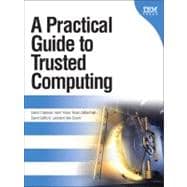
Note: Supplemental materials are not guaranteed with Rental or Used book purchases.
Purchase Benefits
What is included with this book?
David Challener went to work for IBM in East Fishkill after graduating with his Ph.D. in Applied Mathematics from the University of Illinois, (Urbana-Champaign). After helping design the first TPM (representing IBM), he became chair of the TCG TSS committee. When the IBM PC division was sold to Lenovo, he became a Lenovo employee, where he has represented the company on the TCG Technical Committee, TPM workgroup, and many other groups, while continuing to chair the TSS committee. Currently he is the Lenovo Board Member for TCG.
Kent Yoder has been working for the IBM Linux® Technology Center since graduating from Purdue University with a degree in Computer Science in 2001. He has represented IBM on the TCG TSS committee and has helped write and maintain TrouSerS, an open-source TSS library that implements the TSS software specification for the TCG TPM hardware.
Ryan Catherman was a member of the Trusted Computing Group, including active memberships in the TSS and TPM working groups while employed at IBM. He was also coauthor of the IBM implementation of Trusted Computing software at its inception and originator of Unix versions of this software. Currently, he works for Opsware Incorporated, a recent HP acquisition, and holds a masters degree in Computer Engineering.
David Safford is a researcher at IBM’s T. J. Watson Research Center in Hawthorne, New York. There he has led security research in numerous areas, including ethical hacking, threat analysis, security engineering, intrusion detection sensors, vulnerability scanning, cryptography, and operating system security. Prior to coming to IBM in 1996, he was Director of Supercomputing and Networking at Texas A&M University, and an A-7 pilot in the United States Navy.
Leendert van Doorn is a Senior Fellow at AMD where he runs the software technology office. Before joining AMD he was a senior manager at IBM’s T.J. Watson Research Center, where he managed the secure systems and security analysis departments. He received his Ph.D. from the Vrije Universiteit in Amsterdam where he worked on the design and implementation of microkernels. Nowadays his interests are in managed runtime systems, accelerated computing (AMD’s name for heterogenous and homogenous manycore computing), security, and virtualization. In his former job at IBM he worked on FIPS 140-2 level 4 physically secure coprocessors, trusted systems, and virtualization. He was also actively involved in IBM’s virtualization strategy, created and lead IBM’s secure hypervisor and trusted virtual data center initiatives, and was on the board of directors for the Trusted Computing Group. Despite all these distractions, he continued to contribute code to the Xen open-source hypervisor, such as the integrated support code for AMD-V and Intel®VT-x. When conference calls and meetings are getting too much for him, he is known to find refuge at CMU.
| Preface | p. xvii |
| About the Authors | p. xxvii |
| Background Material | |
| Introduction to Trusted Computing | p. 3 |
| Design Goals of the Trusted Platform Module | p. 13 |
| An Overview of the Trusted Platform Module Capabilities | p. 29 |
| Programming Interfaces to TCG | |
| Writing a TPM Device Driver | p. 45 |
| Low-Level Software: Using BIOS and TDDL Directly | p. 59 |
| Trusted Boot | p. 69 |
| The TCG Software Stack | p. 77 |
| Using TPM Keys | p. 103 |
| Using Symmetric Keys | p. 127 |
| The TSS Core Service (TCS) | p. 141 |
| Public Key Cryptography Standard #11 | p. 157 |
| Architectures | |
| Trusted Computing and Secure Storage | p. 181 |
| Trusted Computing and Secure Identification | p. 207 |
| Administration of Trusted Devices | p. 231 |
| Ancillary Hardware | p. 243 |
| Moving from TSS 1.1 to TSS 1.2 | p. 249 |
| Appendixes | |
| TPM Command Reference | p. 293 |
| TSS Command Reference | p. 303 |
| Function Library | p. 321 |
| TSS Functions Grouped by Object and API Level | p. 323 |
| Index | p. 333 |
| Table of Contents provided by Publisher. All Rights Reserved. |
The New copy of this book will include any supplemental materials advertised. Please check the title of the book to determine if it should include any access cards, study guides, lab manuals, CDs, etc.
The Used, Rental and eBook copies of this book are not guaranteed to include any supplemental materials. Typically, only the book itself is included. This is true even if the title states it includes any access cards, study guides, lab manuals, CDs, etc.